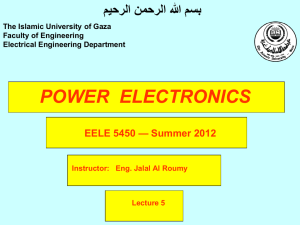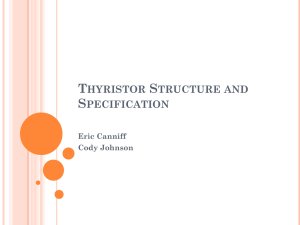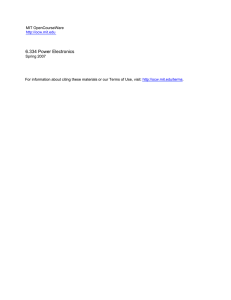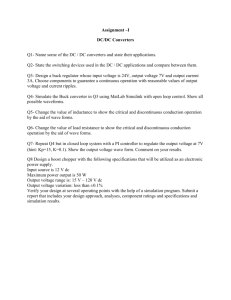Experiment No. 1 Thyristor Characteristic
advertisement
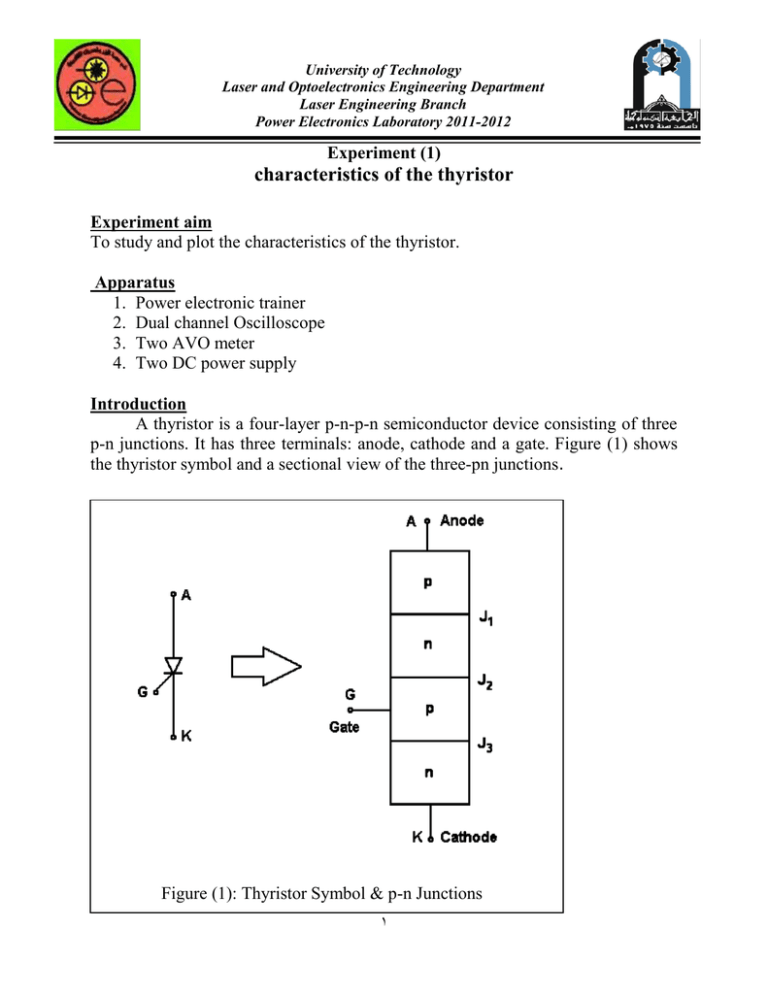
University of Technology Laser and Optoelectronics Engineering Department Laser Engineering Branch Power Electronics Laboratory 2011-2012 Experiment (1) characteristics of the thyristor Experiment aim To study and plot the characteristics of the thyristor. Apparatus 1. Power electronic trainer 2. Dual channel Oscilloscope 3. Two AVO meter 4. Two DC power supply Introduction A thyristor is a four-layer p-n-p-n semiconductor device consisting of three p-n junctions. It has three terminals: anode, cathode and a gate. Figure (1) shows the thyristor symbol and a sectional view of the three-pn junctions. Experiment No. 1 Thyristor Characteristic Figure (1): Thyristor Symbol & p-n Junctions 1 University of Technology Laser and Optoelectronics Engineering Department Laser Engineering Branch Power Electronics Laboratory 2011-2012 When the anode voltage made positive with respect to the cathode, junctions J1 and J3 are forward biased and junction J2 is reverse biased. The thyristor said to be in the forward blocking or off-state condition. A small leakage current flows from anode to cathode and is called the off state current. If the anode voltage VAK is increased to a sufficiently large value, the reverse biased junction J2 would breakdown. This is known as avalanche breakdown and the corresponding voltage is called the forward breakdown voltage VBO. Since the other two junctions J1 and J3 are already forward biased, there will be free movement of carriers across all three junctions. This results in a large forward current. The device now said to be in a conducting or on state. The voltage drop across the device in the on-state is due to the ohmic drop in the four layers and is very small (in the region of 1 V). In the on state the anode current is limited by an external impedance or resistance as shown in figure (2-a). V-I Characteristics of Thyristor Figure (2) shows the V-I characteristics and the circuit used to obtain these characteristics. 2 Figure (2): Thyristor Circuit & V-I Characteristics University of Technology Laser and Optoelectronics Engineering Department Laser Engineering Branch Power Electronics Laboratory 2011-2012 The important points on this characteristic are: 1-Latching Current IL This is the minimum anode current required to maintain the thyristor in the onstate immediately after a thyristor has been turned on and the gate signal has been removed. If a gate current, greater than the threshold gate current is applied until the anode current is greater than the latching current IL then the thyristor will be turned on or triggered. 2-Holding Current IH This is the minimum anode current required to maintain the thyristor in the on state. To turn off a thyristor, the forward anode current must be reduced below its holding current for a sufficient time for mobile charge carriers to vacate the junction. If the anode current is not maintained below IH for long enough, the thyristor will not have returned to the fully blocking state by the time the anode-tocathode voltage rises again. It might then return to the conducting state without an externally applied gate current. 3-Reverse Current IR When the cathode voltage is positive with respect to the anode, the junction J2 is forward biased but junctions J1 and J3 are reverse biased. The thyristor is said to be in the reverse blocking state and a reverse leakage current known as reverse current IR will flow through the device. 4-Forward Break-over Voltage VBO If the forward voltage VAK is increased beyond VBO, the thyristor can be turned on. However, such a turn-on could be destructive. In practice, the forward voltage is maintained below VBO and the thyristor is turned on by applying a positive gate signal between gate and cathode. 5-Once the thyristor is turned on by a gate signal and its anode current is greater than the holding current, the device continues to conduct due to positive feedback even if the gate signal is removed. This is because the thyristor is a latching device and it has been latched to the on state. 3 University of Technology Laser and Optoelectronics Engineering Department Laser Engineering Branch Power Electronics Laboratory 2011-2012 Procedure 1- TO observe the terminal configuration of a thyristor, thyristor's body is generally connected with anode terminal by the manufacture; hence, the anode terminal can be identified with help of a multimeter. Now, measure the resistance between other two terminals (gate and cathode) of the thyrsitor. The forward-biased p-n junction of a diode shows a low resistance than the reverse-biased junction. When the AVO meter shows a low resistance then the gate (G) terminal is the one, which connected with positive terminal of the multi-meter battery. 2- Connect the circuit shown in figure (3). Apply the 30volt across the anode and cathode terminals through 1.1 k resistor. The device must be on the off state with open gate. 3- Increase the gate supply voltage gradually until the thyristor turn on. Recode the minimum gate current (Igmin) required turning on the thyristor. 4- Set the source voltage to zero volts. Adjust the gate voltage to a slightly higher value than what is found in the step (3). Keep the gat voltage constant over the experiment. Increase gradually the source voltage (in steps) so that the anode current (Ia) increased in steps. Open and close the gate terminal after each step. If anode current is greater than the latching current (IL) of the device, then the device stay on even after the gate terminal is opened. 5- Increase the anode current from the latching current level by increasing slightly the supply voltage. Open the gate terminal. Now start reducing the anode current gradually by adjusting the voltage source until the thyristor goes into blocking mode. The anode current at this instant called holding current (IH). 6- Connect the circuit shown in Fig (4). Use the oscilloscope in the X-Y mode, and then connect the point A to channel I and point B to channel II. Draw the shape will appear on the oscilloscope screen. These shape represent the V-I characteristics. 4 University of Technology Laser and Optoelectronics Engineering Department Laser Engineering Branch Power Electronics Laboratory 2011-2012 Discussion 1. 2. 3. 4. What are the conditions for operating a thyristor in the normal operation? From your results , explain the holding and latching current of a thyristor. What is the different between the diode and a thyristor? What is the relation between gate current and anode current of thyristor in conduction period? 5. What are the difference between an (ordinary switch) and a semiconductor switch such as (thyristor and transistor)? Vs RL 1.1k - + Ia + R + SCR + VAK - Vgg Fig.(3): circuit for measuring latching and holding current A RL Ch I T2 R D1 DIODE SCR R 10 B 5 Fig.(4): Measurement of the V-I characteristics of a thyristor Ch II


